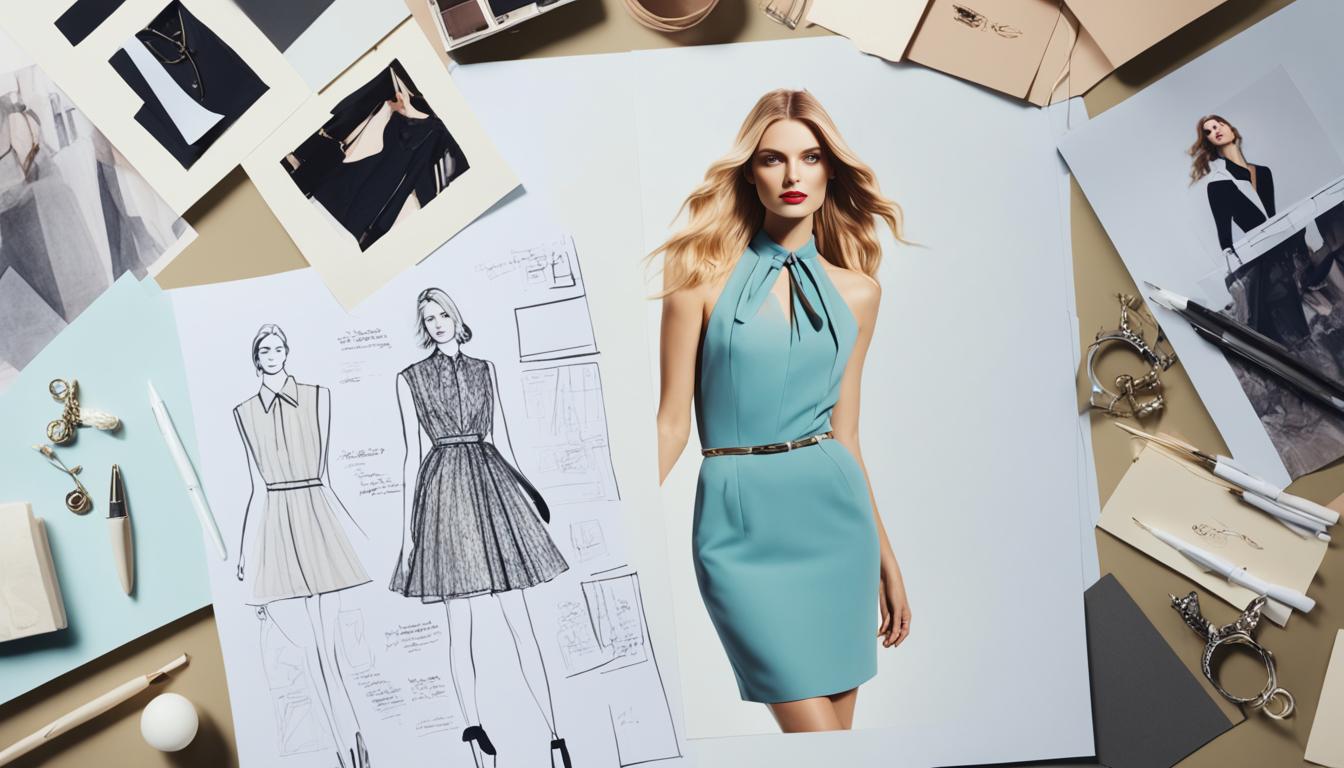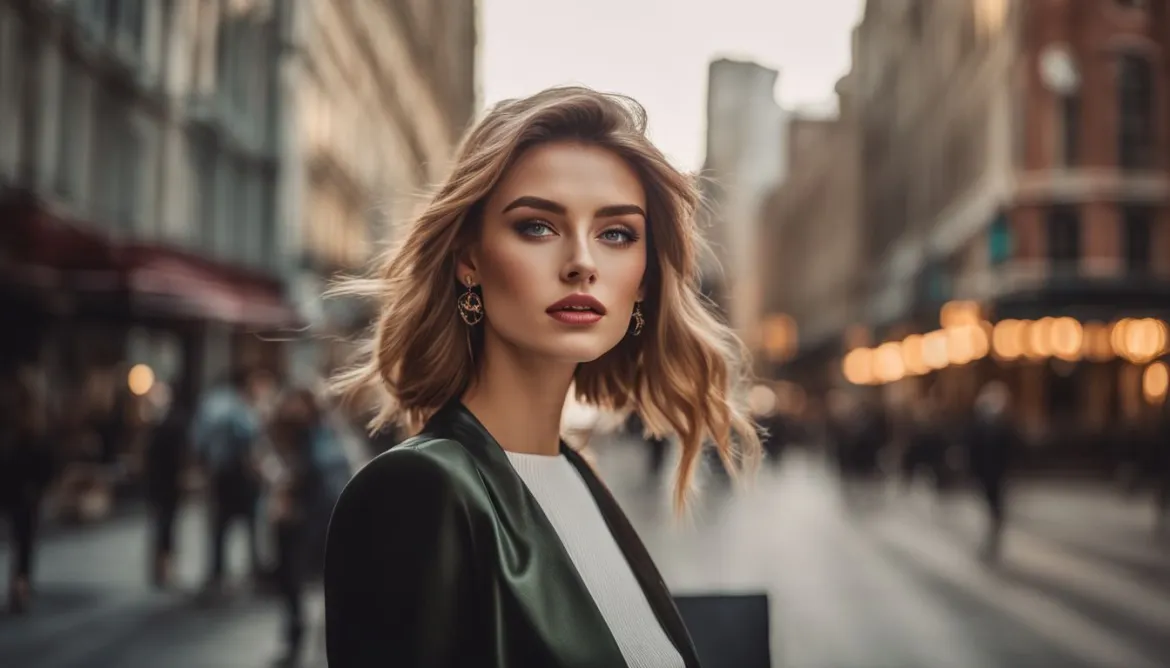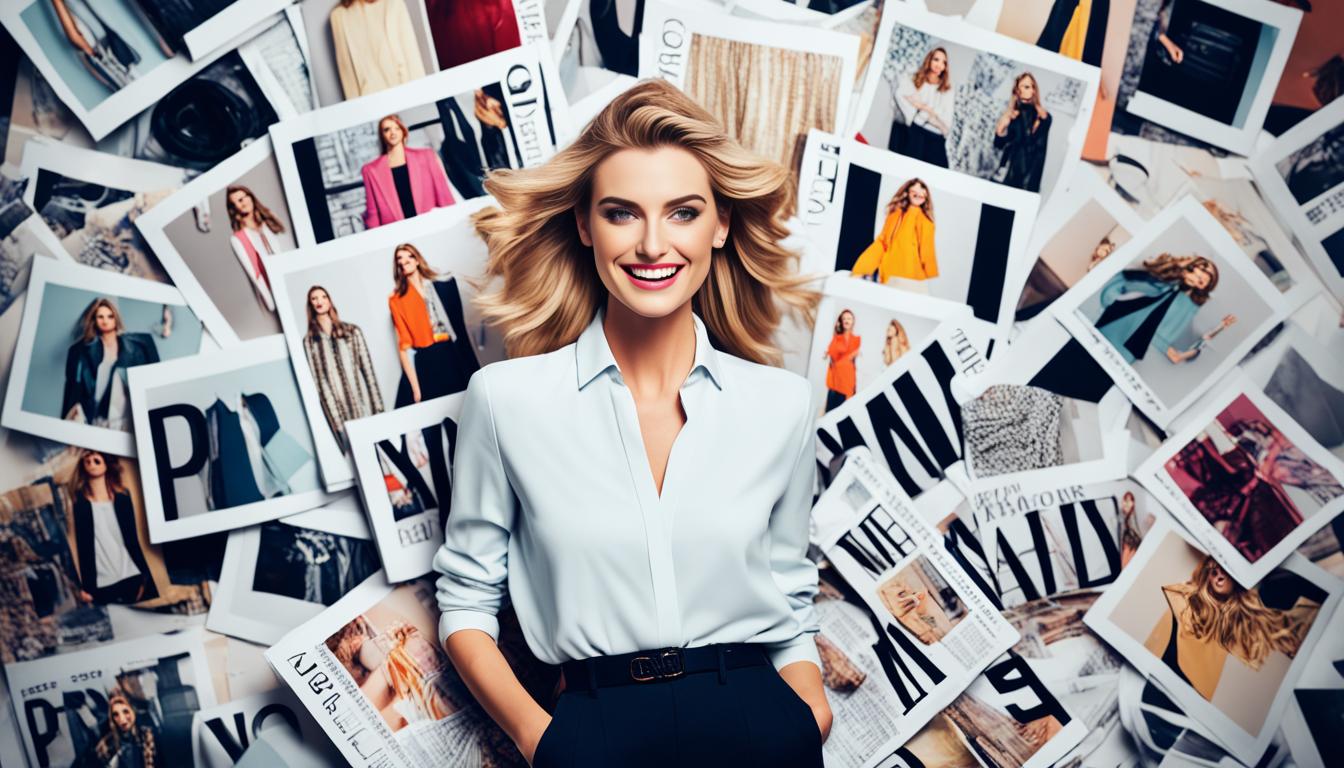Welcome to our guide on mastering fashion editorial shoots! If you’re passionate about fashion photography and aspire to create captivating imagery that tells a visual story, then this article is for you. In this section, we will explore the important aspects of planning and executing a fashion editorial shoot. From professional editorial shoot planning to fashion editorial photography tips, we’ve got you covered.
Key Takeaways:
- Proper planning is crucial for a successful fashion editorial shoot.
- Understanding the industry and key strategies is essential.
- A fashion editorial stylist plays a vital role in curating and styling outfits.
- The producer oversees the entire production process of a fashion shoot.
- Lighting techniques can enhance the visual impact of fashion imagery.
The Role of a Fashion Editorial Stylist
A fashion editorial stylist plays a crucial role in curating and styling outfits, accessories, and overall looks for fashion editorials and photo shoots. They have a keen eye for style and the ability to translate concepts into visually striking stories. As a fashion editorial stylist, we understand the importance of capturing the essence of a brand and bringing it to life through fashion.
When it comes to fashion editorial styling, there are a few key tips and techniques to keep in mind:
- Stay updated with the latest fashion trends: It’s essential to have a deep understanding of current fashion trends and foresee upcoming styles. This knowledge allows us to create looks that are relevant and in-demand, making the editorial shoot visually appealing and engaging.
- Attention to detail: As a stylist, we pay attention to every detail, from the fit of the garments to the choice of accessories. This meticulousness ensures that the overall look is cohesive and polished.
- Experiment with different styling techniques: Fashion styling is an art, and it’s important to experiment with various techniques to create unique and visually captivating looks. This could involve layering, mixing textures, or incorporating unexpected elements into the outfits.
- Collaboration: Fashion editorial shoots are collaborative efforts, and working closely with photographers, models, and other team members is crucial. By understanding their vision and incorporating their input, we can create images that surpass expectations.
Choosing the Right Educational Path
Aspiring fashion editorial stylists have various educational paths to choose from. Fashion design schools offer comprehensive programs that cover fashion history, garment construction, fabric selection, and fashion styling. These programs equip us with the necessary skills and knowledge to succeed in the industry.
Additionally, styling courses provide focused training specifically on fashion styling techniques, editorial shoots, and industry best practices. These courses offer a more streamlined approach for individuals looking to dive straight into fashion editorial styling.
Career Opportunities for Fashion Editorial Stylists
As fashion editorial stylists, our skills and expertise open doors to exciting career opportunities. We can work with fashion magazines, contributing to editorial spreads and cover shoots. Advertising campaigns also require the touch of a skilled stylist to create visual narratives that resonate with the target audience.
Celebrity styling is another avenue where we can showcase our talent. Dressing celebrities for red carpet events, music videos, and photoshoots allows us to collaborate with high-profile individuals and play a role in shaping their public image.
Many fashion brands and e-commerce platforms also seek the expertise of fashion editorial stylists. This involves curating outfits for product launches, lookbooks, and online campaigns to enhance brand identity and drive customer engagement.
As a fashion editorial stylist, our role is multifaceted and ever-evolving. With the right skills, knowledge, and passion for fashion, we can make a profound impact on the visual storytelling of fashion editorials and create images that resonate with audiences.
A fashion editorial stylist at work, curating and styling looks for a photo shoot.
The Role of a Producer in Fashion Shoots
In the world of fashion editorial shoots, the role of a producer is absolutely critical. As a fashion shoot producer, our main responsibility is to oversee every aspect of the production process, ensuring a seamless and successful execution from start to finish.
We collaborate with photographers, customers, and the creative team to develop and execute a concept that aligns perfectly with the brand’s vision.
Our journey begins with concept development. We work closely with the creative team to brainstorm ideas, analyze trends, and bring innovative visions to life. During this phase, we carefully craft the concept, considering various elements such as location, styling, and mood.
“Concept development is like painting a beautiful picture, where every stroke adds depth and character to the final masterpiece.”
Once the concept is finalized, we dive into pre-production. This involves budgeting, scheduling, and securing all the necessary resources for a flawless shoot. We negotiate contracts with suppliers, book locations, arrange permits, and handle any logistical challenges that arise along the way.
Our attention to detail becomes paramount during pre-production, ensuring that everything is in place and ready for a smooth on-set experience.
During the shoot itself, we oversee on-set coordination, ensuring that every aspect runs like clockwork. From managing the models, stylists, hair and makeup artists, to organizing the set design and props, our role is to keep everything and everyone in sync, so all the creative elements come together harmoniously.
“On-set coordination is like conducting an orchestra, where the conductor’s precise direction brings together the beautiful melodies of each instrument.”
After the shoot wraps up, our focus shifts to post-production. We collaborate with the editing team to review and select the best shots, ensuring the final images align with the concept and brand identity. We oversee retouching, color grading, and any additional editing processes, working closely with the creative team to bring the vision to life.
Post-production is the final phase where we meticulously craft the final touches, perfecting the images that will captivate audiences and tell a compelling story.
As fashion shoot producers, we embody the spirit of creativity, organization, and collaboration. We thrive on bringing concepts to life and ensuring a smooth and successful execution, resulting in visually stunning fashion imagery that resonates with audiences.
Essential Lighting Techniques for Fashion Shoots
Lighting plays a crucial role in fashion shoots, creating the desired ambiance and highlighting the subject. To capture visually stunning fashion imagery, photographers utilize a combination of artificial lighting and natural lighting techniques. By mastering these lighting techniques, photographers can elevate their fashion shoots to new heights.
Artificial Lighting Techniques
Artificial lighting allows photographers to have greater control over the lighting conditions and create specific effects. Here are some essential artificial lighting techniques:
- Using Studio Lights: Utilize studio lights like strobes or continuous lights to evenly illuminate the subject and create a controlled environment.
- Softbox Lighting: Softboxes produce soft and flattering light, perfect for highlighting the model’s features and capturing fine details.
- Beauty Dish Lighting: Beauty dishes create crisp and even lighting, emphasizing the model’s facial features and creating flattering shadows.
Natural Lighting Techniques
Natural lighting techniques utilize available light sources to create a natural, airy feel in fashion images. Here are a few essential natural lighting techniques:
- Golden Hour: Shoot during the golden hour, which occurs shortly after sunrise or before sunset, to capture warm, soft light that enhances skin tones and adds an ethereal glow to the images.
- Backlighting: Position the model in front of a strong light source, such as the sun, to create a halo effect and add a sense of drama and depth to the images.
- Dappled Light and Shade: Experiment with shooting in areas with dappled light and shade, creating interesting patterns and textures on the subject.
Lighting Modifiers
Lighting modifiers are essential tools that allow photographers to shape and control the light. Here are some commonly used lighting modifiers:
- Scrims: Scrims diffuse harsh light, creating a softer and more flattering illumination on the subject.
- Reflectors: Reflectors bounce light back onto the subject, filling in shadows and enhancing overall lighting.
- Gels: Gels are colored filters that can be placed in front of lights to create different mood and atmosphere.

| Artificial Lighting Techniques | Natural Lighting Techniques | Lighting Modifiers |
|---|---|---|
| Studio Lights | Golden Hour | Scrims |
| Softbox Lighting | Backlighting | Reflectors |
| Beauty Dish Lighting | Dappled Light and Shade | Gels |
Set Design and Collaboration for Fashion Shoots
Set design and collaboration are vital elements in fashion shoots, playing a significant role in enhancing the visual impact of the images. As fashion photographers, we work closely with a talented and creative team, including stylists, makeup artists, and other professionals, to brainstorm ideas and bring visually engaging sets to life.
By collaborating with our team, we can maximize our talents and create compelling fashion imagery that captivates viewers. We value the input and expertise of each person involved, as it adds depth and creativity to the overall vision of the shoot. Together, we explore various concepts, experimenting with different styles and aesthetics to create a unique and memorable experience.
In building the sets and backgrounds, we employ easily accessible materials that align with the shoot’s concept. Whether it’s repurposing everyday objects or incorporating unconventional elements, we strive to build sets that are visually striking and convey the desired narrative. Each set is thoughtfully designed to complement the fashion, creating a cohesive and impactful visual story.
Collaboration and communication within the creative team are essential for successful set design. By sharing our ideas, inspirations, and insights, we create an environment that encourages creativity and fosters the development of unique concepts. This collaborative process ensures that each member’s skills and expertise are utilized, enhancing the overall quality and impact of the final images.
Through the combined efforts of our creative team, we can build sets and backgrounds that not only amplify the fashion but also elevate the visual storytelling. The collaboration allows us to push boundaries, experiment with new ideas, and create fashion imagery that stands out.
Collaborating for Maximum Impact
“Collaboration is the key to unlocking the full potential of a fashion shoot,” says Sarah Thompson, renowned fashion stylist. “When we work together to create sets that complement the fashion and convey a cohesive narrative, we create images that leave a lasting impression.”
By collaborating with professionals from different disciplines, such as styling, makeup, and set design, photographers can tap into a wealth of creativity and expertise. Sharing ideas and perspectives fosters innovation, resulting in fashion imagery that is unique and visually stunning.
“When we bring together a diverse array of talents and ideas, we can create something truly extraordinary,” adds David Michaels, renowned makeup artist. “Each member of the creative team brings their own unique artistic vision and expertise, which, when combined, elevates the entire shoot.”
Collaboration also allows for the optimization of resources and talents, utilizing each person’s strengths to their fullest potential. By working together, we can overcome challenges and find creative solutions that enhance the concept of the shoot.
As fashion photographers, we understand the importance of collaboration in set design. By embracing teamwork and fostering an environment of creativity and open communication, we can create unique sets and backgrounds that transform fashion photography into a captivating visual experience.
Conclusion
Planning and executing a fashion editorial shoot requires careful thought, attention to detail, and collaboration with a talented team. By mastering the key strategies discussed in this article, such as the role of a fashion editorial stylist, the involvement of a producer in fashion shoots, essential lighting techniques, and set design and collaboration, photographers can create captivating fashion imagery that leaves a lasting impression.
Successful fashion shoots rely on the expertise and creativity of everyone involved. The fashion editorial stylist plays a crucial role in curating and styling the looks, while the producer oversees the entire production process to ensure a smooth execution. Lighting techniques, both artificial and natural, are essential for creating the desired ambiance and highlighting the subject. Set design and collaboration with the creative team allow for the maximization of talents and the creation of unique and visually engaging sets.
With proper planning, execution, and a creative vision, fashion editorial shoots can be successful and rewarding endeavors. By paying attention to every detail and incorporating the key strategies discussed, photographers can master the art of fashion editorial shoots and produce stunning imagery that resonates with audiences.
FAQ
What is the role of a fashion editorial stylist?
A fashion editorial stylist curates and styles outfits, accessories, and looks for fashion editorials and photo shoots. They use their fashion knowledge and creativity to translate concepts into visually striking stories.
How can I become a fashion editorial stylist?
Aspiring fashion editorial stylists can pursue fashion design schools or styling courses to develop their skills. Career opportunities include working for fashion magazines, advertising campaigns, celebrity styling, and fashion brands.
What is the role of a producer in fashion shoots?
The producer oversees the entire production process of a fashion shoot, from concept development to post-production. They handle tasks such as budgeting, scheduling, resource management, logistics, on-set coordination, and post-production processes.
What are essential lighting techniques for fashion shoots?
Fashion photographers use a combination of artificial and natural lighting techniques to create the desired effects. These include shooting in harsh sunlight, utilizing back-lighting, working with dappled light and shade, and incorporating lighting modifiers such as scrims and reflectors.
How important is set design and collaboration in fashion shoots?
Set design and collaboration are crucial aspects of fashion shoots. Fashion photographers work closely with stylists, makeup artists, and other creative professionals to brainstorm ideas and create visually engaging sets. Collaboration allows for the maximization of talents and the creation of compelling fashion imagery.
What are the key strategies for planning and executing a fashion editorial shoot?
Some key strategies for successful fashion editorial shoots include mastering the role of a fashion editorial stylist, involving a producer in the shoot, utilizing essential lighting techniques, and focusing on set design and collaboration. These strategies, when executed well, can result in captivating fashion imagery.
What Role Does Planning and Execution Play in Fashion Editorial Shoots Compared to Styling and Wardrobe?
In the world of fashion editorial shoots, expert fashion shoot styling and planning are crucial. The execution of the styling and wardrobe choices can make or break the success of the shoot. A well-thought-out plan and flawless execution can elevate the overall aesthetic and storytelling of the editorial.




